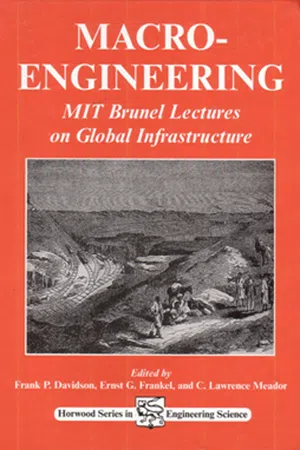
Macro-Engineering
MIT Brunel Lectures on Global Infrastructure
- 210 pages
- English
- ePUB (mobile friendly)
- Available on iOS & Android
About this book
This volume makes available a reflection on large-scale engineering for building a better world. International authorities from engineering, oceanography, academia, public service, and law describe how great and imaginative concepts may be refined, tested, adapted, financed, implemented and put to use. Here are records and commentaries about some of the world's significant engineering achievements, including the planning and design of Nigeria's new capital city, and the use of software by the US military to clean up the Exxon-Valdez oil spill pollution in Alaska.- Describes a method of large-scale engineering for building a better world- Provides records and commentaries about significant engineering achievements- International authorities from engineering, oceanography, academia, public service and law describe how great and imaginative concepts may be refined, tested, adapted, financed and implemented
Frequently asked questions
- Essential is ideal for learners and professionals who enjoy exploring a wide range of subjects. Access the Essential Library with 800,000+ trusted titles and best-sellers across business, personal growth, and the humanities. Includes unlimited reading time and Standard Read Aloud voice.
- Complete: Perfect for advanced learners and researchers needing full, unrestricted access. Unlock 1.4M+ books across hundreds of subjects, including academic and specialized titles. The Complete Plan also includes advanced features like Premium Read Aloud and Research Assistant.
Please note we cannot support devices running on iOS 13 and Android 7 or earlier. Learn more about using the app.
Information
The Suez Canal Re-Visited: 19th Century Global Infrastructure
Publisher Summary
1.1 THE CHIEF MACRO-ENGINEER: FERDINAND DE LESSEPS

1.2 THE BUILDING OF THE SUEZ CANAL
1.2.1 Manpower

1.2.2 Manpower Replaced by Machines
Table of contents
- Cover image
- Title page
- Table of Contents
- Copyright
- Preface
- EDITORIAL NOTE
- Chapter 1: The Suez Canal Re-Visited: 19th Century Global Infrastructure
- Chapter 2: Operation Mulberry: A Floating Transportable Harbor for World War II Normandy Invasion
- Chapter 3: Financial Engineering of the Channel Tunnel
- Chapter 4: Old Cities and New Towns For Tomorrow’s Infrastructure
- Chapter 5: Inland Transport in Europe - Trends and Prospects
- Chapter 6: Lessons Learnt from Major Projects
- Chapter 7: Guided Transportation Systems: Low-Impact, High-Volume, Fail-Safe Travel
- Chapter 8: Prefabricated and Relocatable Artificial Island Technology
- Chapter 9: The Command Tactical Information System: Military Software for Macro-Engineering Projects
- Chapter 10: Prospects for the Next Century: Survey and Suggestions
- INDEX
- Inside Back Cover